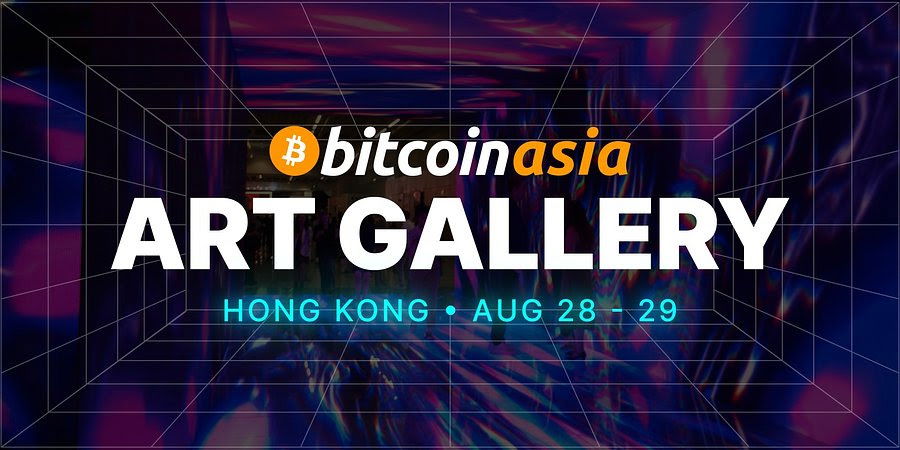| In parallel, Bitcoin Asia will host a fireside chat between former Sotheby’s CEO Tad Smith and Dr. Uli Sigg, the Swiss diplomat, business leader, and preeminent collector of Chinese contemporary art. Their conversation will explore the future of collecting, cultural diplomacy, and the rise of new valuation models. Days after Bitcoin Asia, Sigg will be awarding the prestigious Sigg Prize at M+ Museum—home to over 1,400 works he personally donated to the city’s visual arts landscape. |
“In a moment when the top-tier of the traditional art market is contracting, Bitcoin-native exhibitions are gaining momentum—spanning both physical works priced in BTC and digital creations shaped by the logic of the network itself,” said Dennis Koch, Curator of the Bitcoin Asia Art Gallery. “We’re building something fundamentally different—not just in medium or market, but in ethos. It’s about transparency, sovereignty, and value—for both collectors and artists pursuing what we call creative energy priced in sats.”
| Staged in Hong Kong—Asia’s gateway for both finance and culture—the exhibition signals a growing appetite for Bitcoin-native creative formats across international markets. | | The Bitcoin Asia Art Gallery will include works by over a dozen international artists—including contributors from Hong Kong, Japan, Spain, Germany, the UK, and the US. For the first time in Asia, the exhibit features both a large-scale digital LED wall and a physical gallery space, with a range of fixed-price and auction works. All sales will be priced and transacted in Bitcoin. | | Since 2019, over 100 BTC in sales have been facilitated through the Bitcoin Conference art program, reinforcing a larger market trend: as Bitcoin climbs past $120,000, traditional auction house models are faltering. In 2024, global fine art sales dropped 27% to $10.2 billion, with blue-chip works over $10 million accounting for a $2 billion shortfall. The contraction has continued into 2025, with auction totals down another 16% year-over-year. At the same time, 72% of collectors now buy through digital platforms, and the fastest-growing sector is galleries earning under $250K annually. | | Major art fairs are also in retreat. Both New York’s The Art Show (ADAA) and Taipei Dangdai have announced strategic pauses—New York in 2025 and Taipei in 2026—as rising costs and soft demand prompt a sector-wide reassessment. Rather than a collapse, this signals a paradigm shift in how value, audience, and sustainability are being recalibrated across the global art ecosystem. | | Amid this recalibration, Bitcoin offers a radically different foundation. As Michael Saylor notes, “the only scarcity in the world is Bitcoin”—unlike fiat, real estate, or the traditional store-of-value logic long associated with art collecting. Auction houses are scrambling to adapt through superficial tools like priority bidding, but the deeper shift is already underway: the money itself is changing. Bitcoin-denominated sales offer greater transparency, fewer intermediaries, and a more aligned incentive structure for a new generation of collectors. | | Against this backdrop, Bitcoin Asia is more than a conference; it’s a cultural signal. From rare digital art to generative code-based installations, the exhibition invites collectors, technologists, and curators to reimagine what value looks like in an open-source world. | | Among the standout LED wall contributions is a new work by Harvard professor Scott Kominers, whose generative art series Pidentities explores mathematics, identity, and provenance. Originally launched on Ethereum, the project now makes its Ordinals debut in collaboration with leading developer Ordinally, inscribing the infinite digits of π onto Bitcoin. The resulting installation presents an on-chain, layered puzzle—inviting attendees to decipher hidden clues encoded within the artwork. | | The exhibition will also feature contributions from two of the most iconic Ordinals collections: OnChainMonkey and Bitcoin Puppets, each bringing their distinctive voice to this evolving cultural movement. | Curatorial Team
Dennis Koch is the Art Gallery Director for the Bitcoin Conference, where he has curated Bitcoin-focused exhibitions since 2022, helping shape a cultural economy grounded in sound money. Previously with Gagosian and Blum & Poe, his work centers on artists exploring systems, sovereignty, and value—bringing Bitcoin’s principles into dialogue with contemporary art.
Guoying Stacy Zhang is an art historian specializing in Buddhist art and cultural heritage, with experience at Sotheby’s London and Christie’s Shanghai. She brings a cross-cultural and spiritual perspective to the exhibition, connecting traditional forms of meaning with contemporary expressions of value. |
|
